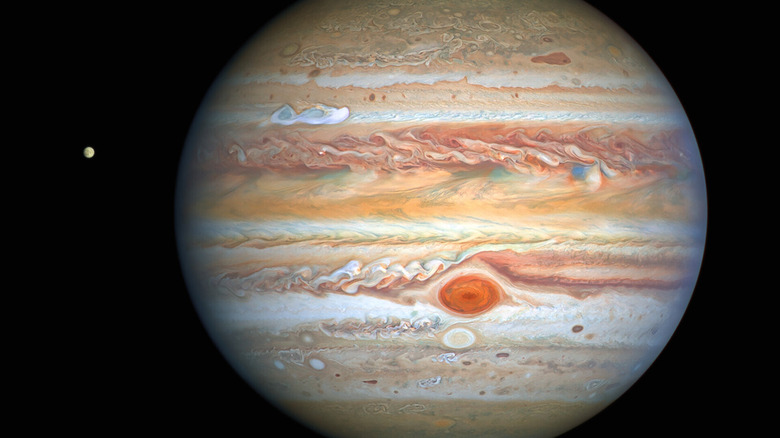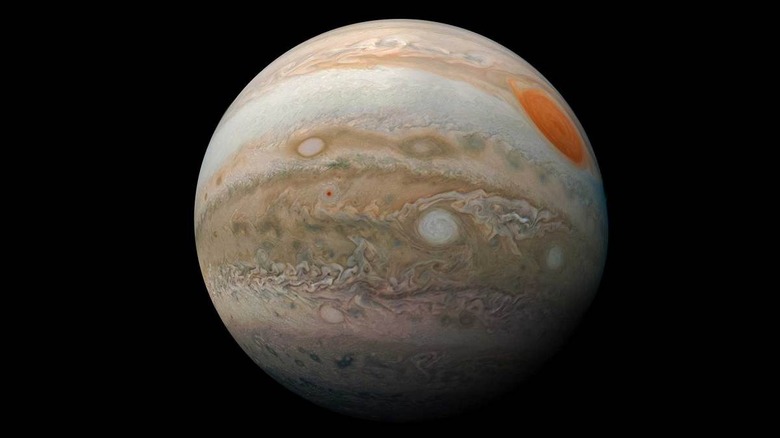Jupiter's Atmosphere Is Full Of Weird Objects Called Mushballs - What Are They?
Jupiter is famous for its striking, stripey appearance, looking like an orange and white marble covered in streaky, complex patterns. But as a gas giant, Jupiter doesn't have a solid surface made of rock like Earth or Mars. Instead, its beautiful appearance is due to its atmosphere, as it has a deep atmosphere with several layers made up of different types of gases.
Just because an atmosphere is gaseous, though, doesn't mean that it's featureless and well mixed. In fact, Jupiter's atmosphere has dramatic weather and structures which scientists are still learning about — including a prevalence of strange objects called mushballs.
Mushballs aren't quite solid like a snowball, but are rather a kind of slushy semi-frozen mixture of ammonia and water. "Imagine a Slushee composed of ammonia and water encased in a hard shell of water ice," suggests research from the University of California, Berkeley.
Recently, researchers discovered that mushballs aren't just an occasional occurrence on Jupiter. Rather, they may be a regular feature in mushball hailstorms on not only Jupiter but also Saturn and the ice giants, Neptune and Uranus, as well.
The research, published in the journal Science Advances, created a 3D visualization of Jupiter's atmosphere, including both its upper layers and a deeper layer called the troposphere. Most research has looked at Jupiter's upper atmosphere, simply because it is more easily visible to us from Earth.
"Every time you look at Jupiter, it's mostly just surface level," said one of the researchers, Chris Moeckel of UC Berkeley. "It's shallow, but a few things — vortices and these big storms — can punch through."
A complex atmosphere
The researchers were trying to see deeper into Jupiter's atmosphere to understand what was happening beneath the swirling clouds that we are used to seeing from far away.
"We're basically showing that the top of the atmosphere is actually a pretty bad representative of what is inside the planet," Moeckel said.
The atmosphere of Jupiter is extremely deep, and because it does not have a solid core, scientists have to make an estimation for what to call its "surface." Typically, they use the point at which there is 1 bar of pressure to define a "surface," which means that it is the region where pressure matches that of sea level on Earth.
Jupiter's atmospheric phenomena, like winds, can reach deep down, to depths of around 2,000 miles into the atmosphere. What we see from the top of the atmosphere is just a fraction of what is going on inside.
"The turbulent cloud tops would lead you to believe that the atmosphere is well mixed," said Moeckel, explaining it as being similar to a pot of boiling water. "If you look at the top, you see it boiling, and you would assume that the whole pot is boiling. But these findings show that even though the top looks like it's boiling, below is a layer that really is very steady and sluggish."
Lacking a surface
The lack of a firm surface has other effects too, especially on the weather and the atmosphere. Scientists know that water and ammonia exist as snow in Jupiter's cold atmosphere, though there isn't much ammonia present in the upper layers of the atmosphere — suggesting that it is falling as rain.
This rain can behave strangely to us though.
"On Earth, you have a surface, and rain will eventually hit this surface," Moeckel said. "The question is: What happens if you take the surface away? How far do the raindrops fall into the planet? This is what we have on the giant planets."
The mushballs in Jupiter's atmosphere are a result of this process. The water and ammonia mixes and forms slushy hailstones which fall through the atmosphere, as ammonia acts like an antifreeze which prevents the balls from freezing solid.
The result is something like the water cycle on Earth, but with different chemicals and in an atmosphere very different from our own.
"The mushball journey essentially starts about 50 to 60 kilometers below the cloud deck as water droplets. The water droplets get rapidly lofted all the way to the top of the cloud deck, where they freeze out and then fall over a hundred kilometers into the planet, where they start to evaporate and deposit material down there," Moeckel said. "And so you have, essentially, this weird system that gets triggered far below the cloud deck, goes all the way to the top of the atmosphere and then sinks deep into the planet."

